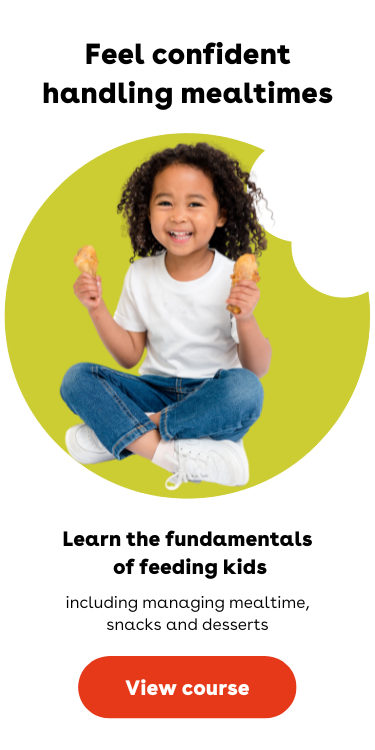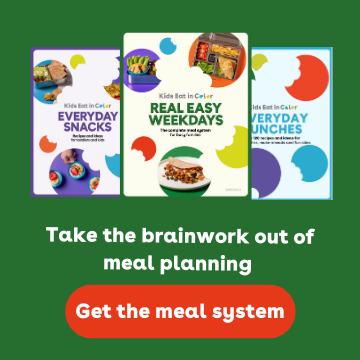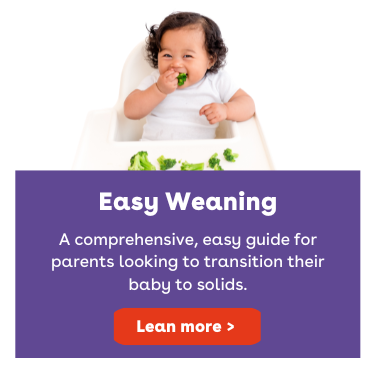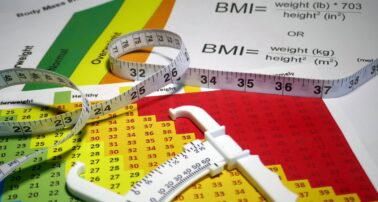Kids Eat in Color provides evidence-based feeding and nutrition tools to families with babies, toddlers and kids. In January 2023, the American Academy of Pediatrics (AAP) released the Clinical Practice Guideline for the Evaluation and Treatment of Children and Adolescents With Obesity (CPG).
Kids Eat in Color thus far has provided evidence-based, weight-neutral feeding and nutrition support to families. “Weight neutral” means that none of the education focuses on changing the weight or size of a child.
The goal of this review was to determine if the Kids Eat in Color recommendations need to change because of new evidence.
Additionally, we want to help parents understand the CPG and how it might change recommendations related to their child’s weight.
In preparation for this statement, among other things, we:
- Thoroughly read and reviewed the CPG and one of the Technical Reports, Appraisal of Clinical Care Practices for Child Obesity Treatment. Part I: Interventions (TR) used to write the CPG.
- Read additional peer-reviewed research articles.
- Arrived at a consensus among our internal team including, registered dietitians, psychologist, pediatrician, child development specialist and occupational therapist (all of whom are listed as co-authors on this article).
- Consulted with volunteer advisor Jose Cucalon Calderon, MD.
- Interviewed Sandra Hassink, MD, FAAP, one of the authors of the CPG.
- Listened to presentations by registered dietitians, a registered nurse and an author discussing the CPG from a Health at Every Size® perspective.
Throughout this statement, many page numbers have been included to show where the information is located in the CPG or TR.
We are responding to the CPG in five parts.
1. Kids Eat in Color summary statement in response to the CPG.
2. Tools for families to use:
3. Portions of the CPG that Kids Eat in Color supports and why.
4. Portions of the CPG that Kids Eat in Color does not support and why, as well as alternatives that Kids Eat in Color would support.
5. Detailed summary and breakdown of the CPG, including questions and answers.
Kids Eat in Color Summary Position Statement
Kids Eat in Color will continue to provide weight-neutral tools and education to families seeking to improve the health of their children.
We have created more tools for families who have a child with weight-related concerns, including how to have successful health-focused medical visits, how to focus on a child’s health instead of weight, and healthy diet and eating recommendations.
We both support and do not support different parts of the CPG.
We support portions of it because:
- The CPG provides a thorough outline of the social and physical determinants of health and weight.
- The CPG emphasizes the importance of eliminating weight bias and stigma in the field of health care.
- The CPG gives a detailed analysis of potential health concerns that are more likely to occur alongside higher weight, and guidance for early diagnostic testing for related health conditions.
We do not support widespread implementation of the treatment guideline given the limitations and gaps in the field:
- At this time, there is no long-term data to support the widespread implementation of the interventions in the CPG (TR pg. 67-70).
- The CPG focuses on weight and body mass index (BMI) instead of weight-neutral healthy lifestyle programming.
- There is not enough data to determine possible benefits versus risks of harm by the CPG (TR pg. 69-70).
The solution to the health challenges of children is complicated.
Food marketing, poverty, racism, the food supply and other factors must be addressed to improve the health of children. These factors and more affect a child’s weight and health, and most are not within a child’s control.
Focusing on weight/BMI decrease puts the responsibility for weight onto the child and their family, even though the child is expected to stay at a high weight, cycling up and down, into adulthood. (CPG pg. 9)
The sense of personal responsibility for something that they will not be able to change could add more to children’s already high psychological and physical burden, further harming their long-term health. A weight-neutral approach, however, may empower families with tools that they can use to support their health consistently over time without the same physical and psychological risks of weight cycling. (1)
Kids Eat in Color would like to see widespread training for motivational interviewing for providers, more robust assessment of harms, including psychological harms, and long-term outcomes data on interventions, before the CPG is implemented on a large scale.
Support for a family’s individual decisions
We support all families with our evidence-based child feeding and nutrition information.
We will support parents and the complex decisions they make, regardless of any treatment they choose to pursue for their child or their family, even if it is a treatment that we are not currently endorsing on a large scale.
We recognize each family’s intent to do what is best for their child. We understand families may choose to participate in any or none of the recommendations of the CPG, including lifestyle programs, medications or surgeries. We recognize that some of these treatments may be helpful to individuals and individual families.
Portions of the CPG that Kids Eat in Color Supports and Why
There are elements of the CPG that have the potential to benefit the health of children.
The release of the CPG so far has sparked conversations among health care providers about how bias, stigma and social determinants of health are affecting the health of children. This has the ability to nurture new ways of thinking in the medical community.
Additionally, there are several other portions of the CPG that we support.
The CPG provides a thorough outline of the social and physical determinants of health and weight.
This is especially true of those in under-resourced communities. From neighborhoods with low resources, to jobs that don’t pay living wages, to adverse childhood experiences such as racism, to food marketing targeting children, to quality of school meals, to a food system that is flooding communities with food that is detrimental to health when it is the only food available, to anti-fat bias and weight stigma, children are suffering the consequences.
Additionally, this analysis makes it very clear that children’s health must be treated holistically.
The author that was interviewed for this statement made the point that if a child doesn’t have enough food, a provider should first establish food security with a family before suggesting other interventions.
The CPG formalizes the importance of connecting families to community resources and of using multi-disciplinary teams to address child health.
While the health care field currently does not employ widespread comprehensive evaluations based on social determinants of health, it is hoped that this CPG will lead to more comprehensive health care for children.
The CPG emphasizes the importance of eliminating weight bias and stigma in the field of health care.
It is a commonly held belief (CPG pg. 2) that higher weights are solely caused by an individual’s personal decisions related to their lifestyle. This belief has led to weight stigma and bias, including in the health care field.
The thorough explanation of the social determinants of health, in addition to the thorough listing of the factors that affect weight, can help replace this belief with a greater understanding that personal choices are just one factor that affects weight out of many factors, 39 of which are listed in the CPG (CPG pg 17). The CPG intends for this knowledge to decrease weight-related bias and stigma.
The CPG acknowledges that it is possible that some groups may be stigmatized more (CPG pg. 3) and it is difficult to tell if an overemphasis on weight will help or harm. We support efforts that educate providers on the social determinants of health and decrease the belief that weight is simply a personal choice.
The CPG gives a detailed analysis of potential health concerns that are more likely to occur alongside higher weight, and a path to early diagnostic tests for the timely knowledge of health conditions.
Some health conditions are more likely to occur in children who also have a high weight. Some of these health conditions, however, do not have symptoms, such as non-alcoholic fatty liver disease or high cholesterol.
Tracking BMI and weight is providing an avenue for insurance coverage of additional testing and treatment.
If children with elevated risk of certain conditions are being screened more regularly, they may be more likely to receive treatment for those conditions before the conditions become more advanced.
Portions of the CPG that Kids Eat in Color Does Not Support and Why, As Well As Alternatives that Kids Eat in Color Would Support
There are elements of the CPG where the potential benefit vs. risk is not known at this time.
In the section above, we outline portions of the CPG that we support. The CPG goes into depth about why those sections are important. Since the CPG does not go into depth about the following topics, we have provided more information.
The CPG recommends that high weight be openly discussed with millions of children and for them to then to be referred to intensive health behavior lifestyle treatment (IHBLT), or more intensive treatments such as medication or surgery, with the goal of losing weight for a specific population. The TR notes that harms are largely unknown (CPG pg. 69-70).
The CPG acknowledges that weight is largely determined by factors outside of an individual’s control, but then the responsibility for changing weight and health is put onto families. In addition to being affected by health risks or health conditions, children and their families could be at risk of psychological harm from weight-focused interventions and of being encouraged to change their bodies as young as 2 or 3 years old.
As a result, Kids Eat in Color is not supporting widespread implementation of the treatments in the CPG.
The following section outlines the reasons why and alternatives that we would support.
At this time, there is no long-term data to support the widespread implementation of the treatments in the CPG (TR pg. 67-70).
The TR lists the following limitations, among others (TR pg. 67-70):
- There was almost no follow-up after the IHBLTs were over. Most had no follow-up after 12 months. We do not know if IHBLTs improve the health of children after they are over.
- There is very little information about what makes a good IHBLT, so it’s hard to recreate the “successful” ones that were studied.
- There is not enough evidence about potential benefits vs. risks.
- “Almost half of the diet and lifestyle randomized controlled trials included in this review were effective in reducing adiposity, at least in the short term.” This means over half of lifestyle programs were not “effective.” It also means that we have no idea what happens when a program is over.
Given the lack of short-term and long-term health data coupled with the gap in the field of thoroughly assessing potential harms (TR pg. 67-70), we do not see enough evidence for widespread implementation of IHBLTs, pharmacotherapy, referral for evaluation for bariatric surgery and universal conversations about BMI.
Alternatives Kids Eat in Color Would Support
Kids Eat in Color supports programs and treatments that have a growing body of evidence. Evidence may include theoretical frameworks, practice-based insight and studies of different designs. For medical interventions that carry a higher level of risk, such as surgery or medication, there would also need to be long-term evidence.
We would support programs, treatments and methodologies that primarily result in behavior change that is both psychologically and physically positive for most participants.
The CPG focuses on weight and BMI instead of weight-neutral healthy lifestyle programming.
The underlying assumption of the CPG is that weight-centric treatment is essential to improve health. Yet, there have been critiques of the weight-centric paradigm and the premise that weight loss leads to improved health outcomes. (1,2,3,4,5)
There is a lack of evidence that IHBLTs “work” in terms of general weight loss and long-term weight loss. The CPG states that weight regain is expected and a child will have weight loss and then weight regain throughout life. (CPG pg. 47) This “weight cycling” is associated with many negative health effects, including increased mortality. (1,6)
Weight-neutral interventions do not focus on weight loss as a treatment, and instead work on increasing health-promoting behaviors such as nutritious diets, physical activity, mental health, stress reduction and others. (1)
The CPG excluded weight-neutral interventions (CPG pg. 7), so it is not possible to know whether weight-neutral or weight-centric interventions are better long term at improving all measures of health and well-being.
There is now a growing body of literature suggesting weight-neutral interventions can improve health behaviors in adults. (1,6) They may also impart long-term behavior change and health metrics, in contrast to weight-centric programs that usually show weight regain without improved health metrics in longer term follow-ups. (1,5)
Additionally, some research suggests increases in cardiorespiratory fitness and physical activity are associated with greater reductions in mortality risk than is intentional weight loss. (6) Most cardiometabolic risk markers associated with higher weight can be improved with physical activity, independent of weight loss. (6)
Given the potential holistic benefits of weight-neutral, health-focused interventions, they could be a better widespread intervention for children and adolescents, without some of the more dangerous side effects of weight loss interventions. (7)
Alternatives Kids Eat in Color Would Support
We would support the following:
- Programs that assist families and communities in improving the social determinants of health in a systematic manner.
- IHBLTs that use weight-neutral programming and messaging with the goal of improving healthy lifestyle behaviors and health outcomes.
- Medical visits that primarily include weight-neutral language, focusing instead on helping families understand any notable changes in growth trajectories if needed.
- Medical visits that encourage achievable behavior change as it relates to improving health, not with the primary goal of weight loss.
We would also support policy efforts that will improve health without putting all of the responsibility on children and families. The CPG described a study that modeled three interventions that would save more in health care costs than it would cost to implement (CPG pg. 67):
- Implementing a tax on sugar-sweetened beverages.
- Eliminating the tax deduction for companies advertising unhealthy foods to children.
- Improving nutrition standards for foods sold in schools outside of meals.
There is not enough data to determine possible benefits versus risks of harm by the CPG (TR pg. 69-70).
According to the TR (TR pg. 69-70):
- Most studies did not look at harms or unintended consequences.
- “Little is known about the psychological effects on children of increasing their awareness of their own condition of obesity.”
- Restrictive dieting is known to contribute to disordered eating patterns, adult obesity, and may worsen the quality of a child’s intake.
- Short-term weight loss may increase a child’s risk of future chronic disease. Short-term weight loss has been shown to lead to weight regain above the initial weight. (8)
We believe it could lead to the following possible harms, but there could be more that are not listed here. The following links can be clicked to read a thorough description of each possible harm along with corresponding references.
Selection of possible harms:
Alternatives Kids Eat in Color Would Support
We support any efforts to train providers in decreasing bias and stigma, to improve their motivational interviewing skills to help families improve their health, and to reduce the risks of some of these harms from occurring.
We would also support interventions that are weight-neutral, focusing on healthy lifestyles.
We would support interventions that have fully explored harms secondary to eating disorders, body image, child maltreatment, mental health or long-term impacts on health, and have been found to have more benefits versus risks of harm.
Descriptions of potential harms
The easy-to-implement interventions of the CPG can be stigmatizing and result in biased care
Here are the easiest and least expensive parts of the CPG to implement:
- BMI screening.
- Diagnosis of “overweight” or “obesity.”
- Talking with a child and their family about a child’s diagnosis.
The CPG describes many things that affect a child’s weight. A child cannot control most of these things.
The CPG recommends telling families that high weight is not their fault. (CPG pg. 33) The provider should not have stigma or bias when they have this conversation. (CPG pg. 14)
While we support this idea, the CPG states that the medical community has weight stigma and bias. (9) A great deal of training is needed before most providers can have a truly non-stigmatizing conversation. Moving away from a weight-centric approach (in which weight loss is the primary goal) to a health-centric approach (in which improving health metrics other than weight is the primary goal) is a strategy that minimizes weight stigma in health care professionals. (10)
If a child already knows they have a high weight, they may already be unhappy with their body. (11,12) If a provider then has a conversation without “tact, empathy and humility,” they may become even more unhappy with their body. (CPG pg. 5)
Parents are often likely to follow advice from their pediatrician or provider, and share the decision-making with their provider. (13,14) If a parent learns their pediatrician is concerned about their child’s weight, it may make parents more willing to consider riskier medication or surgery treatments, when they normally would not have. Additionally, it opens parents up to be manipulated by the diet and wellness industries, which might include unregulated and non-FDA approved products. Parents are advised to always consult with their child’s health care provider prior to giving their child a weight-focused supplement.
Discussing a child’s weight with them may make a child more unhappy with their body and make self-initiated dieting or eating disorders more prevalent
Many families and children are not aware that the child’s high weight may be considered a problem. The CPG acknowledges many times that the family or child may be sad or angry when a provider tells them the child is at a “high weight.” (CPG pg. 15, 27)
The CPG notes that many children have bias against people at high weights. If a child’s high weight is being openly discussed, they could become more unhappy with their body. (15) This can lead to poor mental health. (CPG pg. 4)
By preschool, 20-70% of preschoolers are unhappy with their body and this continues on through adolescence. (16) Body dissatisfaction is a risk factor for eating disorders. (17)
The CPG notes that children at higher weights may use unhealthy practices to try to lose weight. (CPG pg. 30) This might include skipping meals, using diet pills or vomiting. Adolescent dieting and unhealthy weight control behaviors can lead to even greater weight gain over time compared to those who do not use these behaviors. (8)
During puberty, weight often increases. This may be temporary or permanent. It is associated with a higher risk of psychological disorders, including eating disorders. (18)
Introducing weight-related concerns during this time may increase their risk of an eating disorder even more. (19)
As a child is going through treatment with the goal of weight loss, the CPG suggests providers monitor for a greater than expected drop in weight.
A child may already have an eating disorder and assessment and treatment of overweight or obesity may make it worse
The CPG acknowledges many times that eating disorders exist. It also states that children should be screened for eating disorders.
The CPG does not outline the criteria for not recommending an IHBLT because a child has an eating disorder. This is an important gap, and one that needs to be addressed.
A child may be asked to log all behavior, physical activity, and food eaten. After a child is diagnosed with high weight, the child’s lifestyle will be assessed.
The CPG notes that if a child has an eating disorder, OCD or other mental health condition, it may not be appropriate to recommend intense tracking to assess their health since it could make an eating disorder worse. (CPG pg. 30) The CPG doesn’t say how a provider will know whether or not it’s appropriate, and this may be suggested to children who should not be tracking.
Not losing weight despite intentional weight loss efforts may have a negative impact on mental health
When IHBLTs focus on weight, they put the psychological burden of how much the children weigh completely onto the parents and child. Families are told that their child can lose weight or decrease their BMI if they participate in an IHBLT, although the CPG recommends that providers temper the expectations of families who expect that their child will lose a significant amount of weight. (CPG pg. 50) Actual weight loss in “successful” IHBLTs ranged from 3.5 – 17.8 pounds, or showed BMI losses of 0.1 – 4.3. (TR pg. 50)
The TR, however, shows that less than half of interventions are “successful,” and there is almost no data on how long the weight loss lasts. Parents may experience guilt or shame if they learn their feeding practices are unhealthy (CPG pg. 27), and it is possible parents may also experience the same if their child does not experience “success” in an IHBLT.
Because the social determinants of health (poverty, food access, racism, etc.) are discussed as a significant factor in high weight, but without strategies for systemic change in this CPG, we think it is highly unlikely most children will find long-term “successful treatment” (which they consider as weight loss) through IHBLTs. (CPG pg. 3)
In regard to health outcomes, some interventions will be “successful” (child will lose weight). If a child does lose weight, they may have an improvement in health symptoms in the short term. In the long term, however, if a child regains weight, they would need to further restrict to maintain their weight loss, and negative health effects may reemerge.
The CPG states it is possible that certain racial and ethnic (and other) groups will be stigmatized more in a treatment program. (CPG pg. 3)
Certain groups of people have more factors that make health worse. So they will have less “success” in treatments. Those people will be compared to people with fewer factors that make health worse. Then they will be blamed for their poor success. (1) Bias and stigma will increase. (CPG pg. 3)
Weight stigma negatively affects mental health and physical health. (2) The CPG notes that children at a higher weight have higher rates of mood and anxiety disorders. These increase a child’s vulnerability to psychological harm from medical bullying.
It is unclear that the measures of success for IHBLTs are sustainable, lead to long-term health benefits, and help address the social determinants of health, weight stigma and bias.
Unsupportive or abusive parents may physically or psychologically harm a child if told the child weighs too much
Children with Adverse Childhood Experiences (ACEs) are more likely to be at a high weight. It is commonly thought that social disruption, negative health behaviors and chronic stress responses make high weight more likely. (CPG pg. 4)
ACEs include experiences such as (CPG pg. 4):
- Family turmoil.
- Loss of a parent.
- Violence.
- Financial hardship.
- Divorce.
- Abuse.
- Parental mental illness.
If the child has a physically or emotionally abusive caregiver, or if they have a caregiver who has weight stigma and bias, the child might be harmed or stigmatized when the child gets a weight diagnosis.
The CPG does not tell providers what to look for in caregivers, despite the general rates of child abuse and weight stigma.
Children living in poverty are more likely to be at a higher weight and rates of abuse/neglect are 5 times higher for them as well. (20) Openly discussing BMI with all parents will likely cause harm without consideration for whether a parent is unbiased or caring or not.
Potential benefits versus risks of harm are unknown for medications and surgery
In a specific group of children, medication and referral for bariatric surgery may be suggested. The CPG notes that motivational interviewing and IHBLTs should be the first recommended treatments. If those interventions do not yield results and the child meets certain chronic disease criteria, the more intensive treatments may be recommended by the child’s provider.
The CPG describes side effects of some medications. Some of them are severe. Additionally, there is no long-term data about the safety of weight loss medications, especially since many of them are very new.
Bariatric surgery carries risks. The two routinely used procedures are irreversible and can cause malnutrition afterwards if a careful diet is not followed. The child will be impacted by the surgery for the rest of their life. (CPG pg. 63)
Major complications within 30 days of the procedure are reported in 8% of individuals. Related procedures may be required in 13-25% of patients within five years. (CPG pg. 63)
Families must be thoroughly informed about risks from surgery, and it is uncertain whether the current health care system is able to provide enough time and resources to families to make sure they have all of the information that they need.
The potential benefits versus risks of harm are unknown at this time, making it difficult to make decisions.
Risk of motivational interviewing without training harming psychological health
The CPG recommends using Motivational Interviewing (MI) to increase a person’s motivation to change a behavior. It can help families select a goal to work towards with the provider’s support.
MI is based on respectful conversation and is best used when a provider has been trained in how to facilitate it. (21,22) If providers are not trained in MI, which may be difficult given their time restraints, and attempt to use it to change a person’s behavior, they may not encourage healthy behaviors, and end up still lecturing a patient about weight and health unintentionally, which can be harmful to a person’s psychological health.
References
- https://nutritionj.biomedcentral.com/articles/10.1186/1475-2891-10-9
- https://journals.sagepub.com/doi/full/10.1177/2158244018772888
- https://www.ncbi.nlm.nih.gov/pmc/articles/PMC4132299/
- https://pubmed.ncbi.nlm.nih.gov/17469900/
- https://pubmed.ncbi.nlm.nih.gov/15942543/
- https://www.cell.com/iscience/fulltext/S2589-0042(21)00963-9
- https://pubmed.ncbi.nlm.nih.gov/34001715/
- https://pubmed.ncbi.nlm.nih.gov/22188838
- https://pubmed.ncbi.nlm.nih.gov/28249596/
- https://pubmed.ncbi.nlm.nih.gov/35934011/
- https://pubmed.ncbi.nlm.nih.gov/34009006/
- https://pubmed.ncbi.nlm.nih.gov/32981330/
- https://pubmed.ncbi.nlm.nih.gov/20837618/
- https://www.ncbi.nlm.nih.gov/pmc/articles/PMC3756486/
- https://pubmed.ncbi.nlm.nih.gov/30516550/
- https://pubmed.ncbi.nlm.nih.gov/27352102/
- https://pubmed.ncbi.nlm.nih.gov/36899428/
- https://pubmed.ncbi.nlm.nih.gov/31443879/
- https://pubmed.ncbi.nlm.nih.gov/23421694/
- https://www.cdc.gov/violenceprevention/childabuseandneglect/fastfact.html
- https://www.ncbi.nlm.nih.gov/pmc/articles/PMC2890671/
- https://www.ncbi.nlm.nih.gov/pmc/articles/PMC7680367/












Kids Eat in Color provides evidence-based feeding and nutrition tools to families with babies, toddlers and kids. In January 2023, the American Academy of Pediatrics (AAP) released the Clinical Practice Guideline for the Evaluation and Treatment of Children and Adolescents With Obesity (CPG).
Kids Eat in Color thus far has provided evidence-based, weight-neutral feeding and nutrition support to families. “Weight neutral” means that none of the education focuses on changing the weight or size of a child.
The goal of this review was to determine if the Kids Eat in Color recommendations need to change because of new evidence.
Additionally, we want to help parents understand the CPG and how it might change recommendations related to their child’s weight.
In preparation for this statement, among other things, we:
Throughout this statement, many page numbers have been included to show where the information is located in the CPG or TR.
We are responding to the CPG in five parts.
1. Kids Eat in Color summary statement in response to the CPG.
2. Tools for families to use:
3. Portions of the CPG that Kids Eat in Color supports and why.
4. Portions of the CPG that Kids Eat in Color does not support and why, as well as alternatives that Kids Eat in Color would support.
5. Detailed summary and breakdown of the CPG, including questions and answers.
Kids Eat in Color Summary Position Statement
Kids Eat in Color will continue to provide weight-neutral tools and education to families seeking to improve the health of their children.
We have created more tools for families who have a child with weight-related concerns, including how to have successful health-focused medical visits, how to focus on a child’s health instead of weight, and healthy diet and eating recommendations.
We both support and do not support different parts of the CPG.
We support portions of it because:
We do not support widespread implementation of the treatment guideline given the limitations and gaps in the field:
The solution to the health challenges of children is complicated.
Food marketing, poverty, racism, the food supply and other factors must be addressed to improve the health of children. These factors and more affect a child’s weight and health, and most are not within a child’s control.
Focusing on weight/BMI decrease puts the responsibility for weight onto the child and their family, even though the child is expected to stay at a high weight, cycling up and down, into adulthood. (CPG pg. 9)
The sense of personal responsibility for something that they will not be able to change could add more to children’s already high psychological and physical burden, further harming their long-term health. A weight-neutral approach, however, may empower families with tools that they can use to support their health consistently over time without the same physical and psychological risks of weight cycling. (1)
Kids Eat in Color would like to see widespread training for motivational interviewing for providers, more robust assessment of harms, including psychological harms, and long-term outcomes data on interventions, before the CPG is implemented on a large scale.
Support for a family’s individual decisions
We support all families with our evidence-based child feeding and nutrition information.
We will support parents and the complex decisions they make, regardless of any treatment they choose to pursue for their child or their family, even if it is a treatment that we are not currently endorsing on a large scale.
We recognize each family’s intent to do what is best for their child. We understand families may choose to participate in any or none of the recommendations of the CPG, including lifestyle programs, medications or surgeries. We recognize that some of these treatments may be helpful to individuals and individual families.
Portions of the CPG that Kids Eat in Color Supports and Why
There are elements of the CPG that have the potential to benefit the health of children.
The release of the CPG so far has sparked conversations among health care providers about how bias, stigma and social determinants of health are affecting the health of children. This has the ability to nurture new ways of thinking in the medical community.
Additionally, there are several other portions of the CPG that we support.
The CPG provides a thorough outline of the social and physical determinants of health and weight.
This is especially true of those in under-resourced communities. From neighborhoods with low resources, to jobs that don’t pay living wages, to adverse childhood experiences such as racism, to food marketing targeting children, to quality of school meals, to a food system that is flooding communities with food that is detrimental to health when it is the only food available, to anti-fat bias and weight stigma, children are suffering the consequences.
Additionally, this analysis makes it very clear that children’s health must be treated holistically.
The author that was interviewed for this statement made the point that if a child doesn’t have enough food, a provider should first establish food security with a family before suggesting other interventions.
The CPG formalizes the importance of connecting families to community resources and of using multi-disciplinary teams to address child health.
While the health care field currently does not employ widespread comprehensive evaluations based on social determinants of health, it is hoped that this CPG will lead to more comprehensive health care for children.
The CPG emphasizes the importance of eliminating weight bias and stigma in the field of health care.
It is a commonly held belief (CPG pg. 2) that higher weights are solely caused by an individual’s personal decisions related to their lifestyle. This belief has led to weight stigma and bias, including in the health care field.
The thorough explanation of the social determinants of health, in addition to the thorough listing of the factors that affect weight, can help replace this belief with a greater understanding that personal choices are just one factor that affects weight out of many factors, 39 of which are listed in the CPG (CPG pg 17). The CPG intends for this knowledge to decrease weight-related bias and stigma.
The CPG acknowledges that it is possible that some groups may be stigmatized more (CPG pg. 3) and it is difficult to tell if an overemphasis on weight will help or harm. We support efforts that educate providers on the social determinants of health and decrease the belief that weight is simply a personal choice.
The CPG gives a detailed analysis of potential health concerns that are more likely to occur alongside higher weight, and a path to early diagnostic tests for the timely knowledge of health conditions.
Some health conditions are more likely to occur in children who also have a high weight. Some of these health conditions, however, do not have symptoms, such as non-alcoholic fatty liver disease or high cholesterol.
Tracking BMI and weight is providing an avenue for insurance coverage of additional testing and treatment.
If children with elevated risk of certain conditions are being screened more regularly, they may be more likely to receive treatment for those conditions before the conditions become more advanced.
Portions of the CPG that Kids Eat in Color Does Not Support and Why, As Well As Alternatives that Kids Eat in Color Would Support
There are elements of the CPG where the potential benefit vs. risk is not known at this time.
In the section above, we outline portions of the CPG that we support. The CPG goes into depth about why those sections are important. Since the CPG does not go into depth about the following topics, we have provided more information.
The CPG recommends that high weight be openly discussed with millions of children and for them to then to be referred to intensive health behavior lifestyle treatment (IHBLT), or more intensive treatments such as medication or surgery, with the goal of losing weight for a specific population. The TR notes that harms are largely unknown (CPG pg. 69-70).
The CPG acknowledges that weight is largely determined by factors outside of an individual’s control, but then the responsibility for changing weight and health is put onto families. In addition to being affected by health risks or health conditions, children and their families could be at risk of psychological harm from weight-focused interventions and of being encouraged to change their bodies as young as 2 or 3 years old.
As a result, Kids Eat in Color is not supporting widespread implementation of the treatments in the CPG.
The following section outlines the reasons why and alternatives that we would support.
At this time, there is no long-term data to support the widespread implementation of the treatments in the CPG (TR pg. 67-70).
The TR lists the following limitations, among others (TR pg. 67-70):
Given the lack of short-term and long-term health data coupled with the gap in the field of thoroughly assessing potential harms (TR pg. 67-70), we do not see enough evidence for widespread implementation of IHBLTs, pharmacotherapy, referral for evaluation for bariatric surgery and universal conversations about BMI.
Alternatives Kids Eat in Color Would Support
Kids Eat in Color supports programs and treatments that have a growing body of evidence. Evidence may include theoretical frameworks, practice-based insight and studies of different designs. For medical interventions that carry a higher level of risk, such as surgery or medication, there would also need to be long-term evidence.
We would support programs, treatments and methodologies that primarily result in behavior change that is both psychologically and physically positive for most participants.
The CPG focuses on weight and BMI instead of weight-neutral healthy lifestyle programming.
The underlying assumption of the CPG is that weight-centric treatment is essential to improve health. Yet, there have been critiques of the weight-centric paradigm and the premise that weight loss leads to improved health outcomes. (1,2,3,4,5)
There is a lack of evidence that IHBLTs “work” in terms of general weight loss and long-term weight loss. The CPG states that weight regain is expected and a child will have weight loss and then weight regain throughout life. (CPG pg. 47) This “weight cycling” is associated with many negative health effects, including increased mortality. (1,6)
Weight-neutral interventions do not focus on weight loss as a treatment, and instead work on increasing health-promoting behaviors such as nutritious diets, physical activity, mental health, stress reduction and others. (1)
The CPG excluded weight-neutral interventions (CPG pg. 7), so it is not possible to know whether weight-neutral or weight-centric interventions are better long term at improving all measures of health and well-being.
There is now a growing body of literature suggesting weight-neutral interventions can improve health behaviors in adults. (1,6) They may also impart long-term behavior change and health metrics, in contrast to weight-centric programs that usually show weight regain without improved health metrics in longer term follow-ups. (1,5)
Additionally, some research suggests increases in cardiorespiratory fitness and physical activity are associated with greater reductions in mortality risk than is intentional weight loss. (6) Most cardiometabolic risk markers associated with higher weight can be improved with physical activity, independent of weight loss. (6)
Given the potential holistic benefits of weight-neutral, health-focused interventions, they could be a better widespread intervention for children and adolescents, without some of the more dangerous side effects of weight loss interventions. (7)
Alternatives Kids Eat in Color Would Support
We would support the following:
We would also support policy efforts that will improve health without putting all of the responsibility on children and families. The CPG described a study that modeled three interventions that would save more in health care costs than it would cost to implement (CPG pg. 67):
There is not enough data to determine possible benefits versus risks of harm by the CPG (TR pg. 69-70).
According to the TR (TR pg. 69-70):
We believe it could lead to the following possible harms, but there could be more that are not listed here. The following links can be clicked to read a thorough description of each possible harm along with corresponding references.
Selection of possible harms:
Alternatives Kids Eat in Color Would Support
We support any efforts to train providers in decreasing bias and stigma, to improve their motivational interviewing skills to help families improve their health, and to reduce the risks of some of these harms from occurring.
We would also support interventions that are weight-neutral, focusing on healthy lifestyles.
We would support interventions that have fully explored harms secondary to eating disorders, body image, child maltreatment, mental health or long-term impacts on health, and have been found to have more benefits versus risks of harm.
Descriptions of potential harms
The easy-to-implement interventions of the CPG can be stigmatizing and result in biased care
Here are the easiest and least expensive parts of the CPG to implement:
The CPG describes many things that affect a child’s weight. A child cannot control most of these things.
The CPG recommends telling families that high weight is not their fault. (CPG pg. 33) The provider should not have stigma or bias when they have this conversation. (CPG pg. 14)
While we support this idea, the CPG states that the medical community has weight stigma and bias. (9) A great deal of training is needed before most providers can have a truly non-stigmatizing conversation. Moving away from a weight-centric approach (in which weight loss is the primary goal) to a health-centric approach (in which improving health metrics other than weight is the primary goal) is a strategy that minimizes weight stigma in health care professionals. (10)
If a child already knows they have a high weight, they may already be unhappy with their body. (11,12) If a provider then has a conversation without “tact, empathy and humility,” they may become even more unhappy with their body. (CPG pg. 5)
Parents are often likely to follow advice from their pediatrician or provider, and share the decision-making with their provider. (13,14) If a parent learns their pediatrician is concerned about their child’s weight, it may make parents more willing to consider riskier medication or surgery treatments, when they normally would not have. Additionally, it opens parents up to be manipulated by the diet and wellness industries, which might include unregulated and non-FDA approved products. Parents are advised to always consult with their child’s health care provider prior to giving their child a weight-focused supplement.
Discussing a child’s weight with them may make a child more unhappy with their body and make self-initiated dieting or eating disorders more prevalent
Many families and children are not aware that the child’s high weight may be considered a problem. The CPG acknowledges many times that the family or child may be sad or angry when a provider tells them the child is at a “high weight.” (CPG pg. 15, 27)
The CPG notes that many children have bias against people at high weights. If a child’s high weight is being openly discussed, they could become more unhappy with their body. (15) This can lead to poor mental health. (CPG pg. 4)
By preschool, 20-70% of preschoolers are unhappy with their body and this continues on through adolescence. (16) Body dissatisfaction is a risk factor for eating disorders. (17)
The CPG notes that children at higher weights may use unhealthy practices to try to lose weight. (CPG pg. 30) This might include skipping meals, using diet pills or vomiting. Adolescent dieting and unhealthy weight control behaviors can lead to even greater weight gain over time compared to those who do not use these behaviors. (8)
During puberty, weight often increases. This may be temporary or permanent. It is associated with a higher risk of psychological disorders, including eating disorders. (18)
Introducing weight-related concerns during this time may increase their risk of an eating disorder even more. (19)
As a child is going through treatment with the goal of weight loss, the CPG suggests providers monitor for a greater than expected drop in weight.
A child may already have an eating disorder and assessment and treatment of overweight or obesity may make it worse
The CPG acknowledges many times that eating disorders exist. It also states that children should be screened for eating disorders.
The CPG does not outline the criteria for not recommending an IHBLT because a child has an eating disorder. This is an important gap, and one that needs to be addressed.
A child may be asked to log all behavior, physical activity, and food eaten. After a child is diagnosed with high weight, the child’s lifestyle will be assessed.
The CPG notes that if a child has an eating disorder, OCD or other mental health condition, it may not be appropriate to recommend intense tracking to assess their health since it could make an eating disorder worse. (CPG pg. 30) The CPG doesn’t say how a provider will know whether or not it’s appropriate, and this may be suggested to children who should not be tracking.
Not losing weight despite intentional weight loss efforts may have a negative impact on mental health
When IHBLTs focus on weight, they put the psychological burden of how much the children weigh completely onto the parents and child. Families are told that their child can lose weight or decrease their BMI if they participate in an IHBLT, although the CPG recommends that providers temper the expectations of families who expect that their child will lose a significant amount of weight. (CPG pg. 50) Actual weight loss in “successful” IHBLTs ranged from 3.5 – 17.8 pounds, or showed BMI losses of 0.1 – 4.3. (TR pg. 50)
The TR, however, shows that less than half of interventions are “successful,” and there is almost no data on how long the weight loss lasts. Parents may experience guilt or shame if they learn their feeding practices are unhealthy (CPG pg. 27), and it is possible parents may also experience the same if their child does not experience “success” in an IHBLT.
Because the social determinants of health (poverty, food access, racism, etc.) are discussed as a significant factor in high weight, but without strategies for systemic change in this CPG, we think it is highly unlikely most children will find long-term “successful treatment” (which they consider as weight loss) through IHBLTs. (CPG pg. 3)
In regard to health outcomes, some interventions will be “successful” (child will lose weight). If a child does lose weight, they may have an improvement in health symptoms in the short term. In the long term, however, if a child regains weight, they would need to further restrict to maintain their weight loss, and negative health effects may reemerge.
The CPG states it is possible that certain racial and ethnic (and other) groups will be stigmatized more in a treatment program. (CPG pg. 3)
Certain groups of people have more factors that make health worse. So they will have less “success” in treatments. Those people will be compared to people with fewer factors that make health worse. Then they will be blamed for their poor success. (1) Bias and stigma will increase. (CPG pg. 3)
Weight stigma negatively affects mental health and physical health. (2) The CPG notes that children at a higher weight have higher rates of mood and anxiety disorders. These increase a child’s vulnerability to psychological harm from medical bullying.
It is unclear that the measures of success for IHBLTs are sustainable, lead to long-term health benefits, and help address the social determinants of health, weight stigma and bias.
Unsupportive or abusive parents may physically or psychologically harm a child if told the child weighs too much
Children with Adverse Childhood Experiences (ACEs) are more likely to be at a high weight. It is commonly thought that social disruption, negative health behaviors and chronic stress responses make high weight more likely. (CPG pg. 4)
ACEs include experiences such as (CPG pg. 4):
If the child has a physically or emotionally abusive caregiver, or if they have a caregiver who has weight stigma and bias, the child might be harmed or stigmatized when the child gets a weight diagnosis.
The CPG does not tell providers what to look for in caregivers, despite the general rates of child abuse and weight stigma.
Children living in poverty are more likely to be at a higher weight and rates of abuse/neglect are 5 times higher for them as well. (20) Openly discussing BMI with all parents will likely cause harm without consideration for whether a parent is unbiased or caring or not.
Potential benefits versus risks of harm are unknown for medications and surgery
In a specific group of children, medication and referral for bariatric surgery may be suggested. The CPG notes that motivational interviewing and IHBLTs should be the first recommended treatments. If those interventions do not yield results and the child meets certain chronic disease criteria, the more intensive treatments may be recommended by the child’s provider.
The CPG describes side effects of some medications. Some of them are severe. Additionally, there is no long-term data about the safety of weight loss medications, especially since many of them are very new.
Bariatric surgery carries risks. The two routinely used procedures are irreversible and can cause malnutrition afterwards if a careful diet is not followed. The child will be impacted by the surgery for the rest of their life. (CPG pg. 63)
Major complications within 30 days of the procedure are reported in 8% of individuals. Related procedures may be required in 13-25% of patients within five years. (CPG pg. 63)
Families must be thoroughly informed about risks from surgery, and it is uncertain whether the current health care system is able to provide enough time and resources to families to make sure they have all of the information that they need.
The potential benefits versus risks of harm are unknown at this time, making it difficult to make decisions.
Risk of motivational interviewing without training harming psychological health
The CPG recommends using Motivational Interviewing (MI) to increase a person’s motivation to change a behavior. It can help families select a goal to work towards with the provider’s support.
MI is based on respectful conversation and is best used when a provider has been trained in how to facilitate it. (21,22) If providers are not trained in MI, which may be difficult given their time restraints, and attempt to use it to change a person’s behavior, they may not encourage healthy behaviors, and end up still lecturing a patient about weight and health unintentionally, which can be harmful to a person’s psychological health.
References